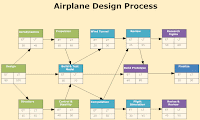Weekly Questions (Week 11)
Chapter 11: Systems Development And Project Management
- Explain the triple constraint and its importance in project management.
The triple constraint refers to the interdependent relationship between the 3 primary variables of a project. These variables include Scope, Resources and Time, whereby an alteration/change in one will inevitably impact and change the other 2 variables.
Project management can be defined as the discipline of planning, organizing and application of skills, knowledge and tools to complete project requirements in order to achieve goals and objectives. As time and resources are limited, understanding the triple constraint framework will allow a project manager a greater possibility to complete projects.
For further information, visit:
http://programsuccess.wordpress.com/2011/05/02/scope-time-and-cost-managing-the-triple-constraint/
For further information, visit:
http://programsuccess.wordpress.com/2011/05/02/scope-time-and-cost-managing-the-triple-constraint/
- Describe the two primary diagrams most frequently used in project planning
Two diagrams which are used in project management include:
 |
| Diagram 2 (PERT Chart) |
- PERT Chart – Program Evaluation And Review Technique Chart is a graphical model which provides a visual representation of a project’s tasks and the relationship between these tasks (dependency). In a PERT Chart, the schedule and starting and ending times of a particular project task are displayed. There are also arrows connecting tasks together indicating the dependence on the completion of one task is essential for the start of another.
- Gantt Chart – a bar chart which provides a visual representation of the scheduled project tasks with the calendar, whereby the tasks are on the vertical axis and the time frame on the horizontal axis
 |
| Diagram 3 (Gantt Chart) |
- Identify the three primary areas a project manager must focus on managing to ensure success
Three primary areas include:
- Manage people from different sections of the business (cross functional teams)
- Resolving conflicts which may arise
- Balancing professional and personal needs with the needs of the project.
Managing Communication
- The channels of communication should be a formal part of the project management plan.(Communications plan)
- Managers need to communicate accurate, meaningful and timely information
Managing Change
 |
| Diagram 6 |
- Change is inevitable and successful businesses anticipate and react to change
- Change management are techniques used to assist the process of implementing changes to a business.
- Examples of change include the implementation of new information systems, change in legislation requiring new requirements or the change in time and resources available.
- Outline 2 reasons why projects fail and two reasons why projects succeed.
Reasons Projects fail:
- Failure to or lack of communicate between personnel
- Projects expectations may be unrelistic
Reasons Projects succeed:
- Goals of the project are SMART (Specific, Measurable, Achievable, Realistic, Time scaled)
- Constant communication between stakeholders and presenting accurate information
For further information, visit:http://www.flyingsolo.com.au/working-smarter/project-management/project-management-why-projects-fail
















